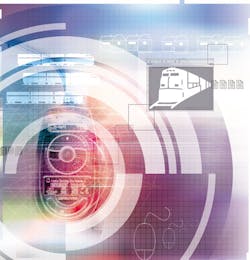The nature of many pharmaceutical, home care and personal care intermediates is that they are chemically active. For many years, Croda Inc.’s Mill Hall, Pa., facility faced a worrisome possibility: liquids arriving in rail tank cars were capable of reacting with residue from previous contents. Should contamination be present, any exothermic reaction would be signaled by temperature rises. Temperature rises are easily monitored with sensors, but the cars could be positioned anywhere along a 1,400 foot rail stub, and they could be moved at any time, so maintaining a continuous view on a car’s internal temperatures was problematic.
“We simply could not wire to the cars,” says Croda Instrument and Electrical Designer Denny Fetter. “You can’t make slip rings that long, and you can’t run wires across an active yard. As a result, we had to send a guy regularly around to the cars with a temperature probe and a clipboard, and hope that the instrument stayed on calibration, and that the sampling methodology was followed—and that the temperatures were recorded accurately.”
Weather was an issue as well. Summer heat could accelerate any reaction due to contamination. Winter brought its own challenges: snow and ice turned climbing up tank cars into a potentially hazardous occupation. Long aware of the distance-spanning features of wireless, Fetter kept an eye on radio-based, point-to-point technologies. A wireless sensor could be quickly set into a tank car, where it could provide regular transmission of heat levels for as long as the car remained on the siding.
“The primary sticking point was security,” he says. “That, and reliability. We didn’t want any other radio signals in the area to interfere with the heat sensor’s data, and we couldn’t afford a failure.”
A self-confessed engineering conservative—Fetter’s background is in nuclear engineering—he installed wireless equipment from Emerson Process Management, the Austin, Texas-based controls vendor, only after he was convinced of its security and reliability. About a year ago, Fetter oversaw the installation of wireless temperature sensors for the cars, plus two intermediate transmitters to act as repeaters. The Emerson 900 megahertz (MHz) equipment employs a self-organizing, self-healing network chip from Dust Networks Inc, Hayward, Calif. The installation now provides minute-by-minute updates of car contents temperature to the plant’s central process host; notification occurs if the temperature rise exceeds a trigger point.
The biggest learning curve? “Integrating the wireless into our existing wired infrastructure, including security engineering. But then, if the wireless side had directly interfaced to the control system without security, we would never have considered it. We need the security, so we were prepared for a little work on the integration.
“We have demonstrated redundancy, with redundant transmitters and redundant gateways into the plant system,” Fetter says. “We have made sure that we meet safety requirements, and we can expand the number of devices at any point we need them. I am,” he adds, “a wireless convert.”
About the Author
Dave Gehman
Contributing Editor

Leaders relevant to this article:
